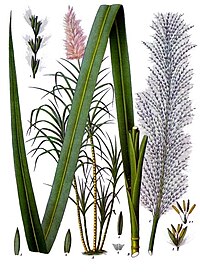
Photo from wikipedia
To study the influence of foliage density and distribution on spray droplets distribution inside plant canopy, the optical porosity of vertically stratified layers of cotton canopy, was proposed to quantitatively… Click to show full abstract
To study the influence of foliage density and distribution on spray droplets distribution inside plant canopy, the optical porosity of vertically stratified layers of cotton canopy, was proposed to quantitatively depict the spatial distribution of cotton foliage. For calculating stratification porosity, a laser ranging bench was built to obtain ranging data for all the stratified layers. For acquiring droplet distribution data inside plant canopy, spray experiments were carried out by using artificial cotton plants as targets and water sensitive papers as a deposit sampling method. Using stratification porosities and droplets distribution data as training data, Gaussian process (GP)-based models were established to quantitatively identify droplet spatial distribution inside the canopy. The trained models predicted droplet distribution of the upper (UL) and middle layers (ML) with mean absolute percentage errors (MAPE) 0.0226, R2 0.9309 and MAPE 0.0526 and R2 0.9039, respectively. Prediction accuracy for the lower layer (LL) was MAPE 0.1181, R2 0.3361. Furthermore, for droplet distributions of the different sections in the same layer, prediction accuracies for UL and ML were obtained with MAPE 0.2038, R2 0.9114 and MAPE 0.3641, R2 0.822, respectively. For prediction accuracy of the LL was MAPE 0.2468, R2 0.4899. Considering the complex influence of all three foliage layers on droplets distribution of LL, and the horizontal velocity component of droplet movement, stratification porosity data could not explain droplets horizontal distribution in LL. Other description parameters should be included to improve model performance in future work. Moreover, the prediction model quantitatively revealed a uniform spray method could not produce a uniform deposition on the target, due to the interception of droplets by spatially inhomogeneous-distributed foliage.
Journal Title: Biosystems Engineering
Year Published: 2021
Link to full text (if available)
Share on Social Media: Sign Up to like & get
recommendations!